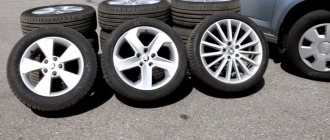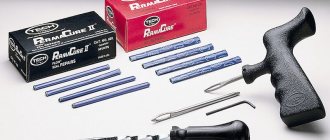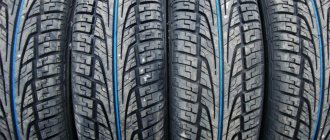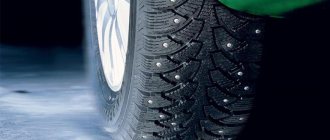Every good vehicle owner has two sets of tires: winter and summer. While one is in use, the other lies in storage in a secluded place, waiting for its season. Therefore, it turns out that each set is inactive for six months. Taking this into account, you should know how to properly store tires without rims and assembled ones, and what rules to follow to maintain their functionality at a high level.
Do not keep tires in the same room with chemicals such as solvents, fuels and lubricants, paints
Tire storage features
Before storing wheels, a thorough inspection should be carried out to ensure that they are suitable for further use. Each tire has wear indicators that help determine the remaining wear. In addition, it is worth examining them for cracks, bumps and hernias.
Important! Before removal, you must mark each tire with a white marker. This will allow you to easily install them in place in the new season and avoid premature wear.
Before storing car tires for seasonal storage, you need to thoroughly clean them of dirt and stones stuck in the tread, as this will accelerate the aging of the rubber and negatively affect its condition.
After complete drying, you need to place the wheels in textile covers made of breathable material, which will ensure air circulation. If they are not available, you can store the tires in plastic bags, but make small holes for ventilation so that condensation does not accumulate inside. It can cause wheel corrosion and rubber over-wetting.
General rules for storing wheels assembled and without rims:
- It is necessary to adhere to a certain temperature regime and avoid sudden changes.
- Tires should be no closer than 1 m from heating devices.
- Complete and non-rimmed wheels should be stored in different positions to avoid deformation.
- Every two months you should turn the wheels and change the fulcrum.
- Tires can be stored outdoors for no more than a month under a canopy or shelter that protects them from external factors.
- It is unacceptable to store wheels on a wet or frozen surface, otherwise deformation cannot be avoided.
- Do not rest tires on sharp objects.
- Do not place heavy objects on top of the wheels.
Facilities
Tire preservation has many advantages, the main ones being:
- Increased tire life.
- Protection from negative factors such as heat, cold, high humidity, as well as from pollution.
- Masking of minor defects.
Silicone oil
The most popular oil for treating car tires, as well as door seals and wiper blades among motorists is PMS-200. You can find containers of different sizes on sale; the average price of oil is 1,500 rubles per 500 ml.
It has a medium viscosity, and therefore is consumed sparingly . To preserve tires, you must first apply oil to a sponge, and then treat the rubber with it so that the product spreads evenly over the entire surface.
The main advantage of PMS-200 is its high concentration of silicone. Thanks to this, the oil protects tires from the negative effects of ultraviolet radiation, condensation, and dust. The product is environmentally friendly, non-toxic, and does not cause irritation. However, it is best to work with it while wearing gloves to prevent allergic reactions.
Air conditioners
These preservation products are available in several versions: sprays, liquid concentrates, and conditioner-cleaners. The most convenient are aerosols, which are simply sprayed onto the surface to be treated. Their main goal is to protect rubber from negative factors.
Some air conditioners perform several functions:
- restoration of the appearance of tires;
- return of shine;
- prevent cracks from appearing.
Verylube spray has these properties. It is suitable for processing rubber surfaces as well as plastic products.
The preservative Koch Cheimie Gummi - KunstStoff has proven itself well . It not only protects surfaces, but also copes with old dirt. The product is applied using a sponge applicator.
Tires should be processed in two stages: first clockwise, then counterclockwise. This will raise the fibers on the tires, allowing the preservative to penetrate as deeply as possible into the tread.
Preservatives
Among preservatives, Toal-Mix concentrate is the leader . Before use, it is diluted with warm water (not higher than +50 degrees), and then applied to the surface using acid or spray. The tires are then wrapped in stretch tape.
Manufacturers of the product assure that after such treatment, tires can be stored for up to 5 years. And even after a long period of time, they will retain their original appearance and properties.
After unpacking, the tires should be carefully washed with water. Thanks to Toal-Mix, the rubber does not harden or dry out.
Silicone Grease
This product is universal because it is used to treat various surfaces, including car tires. Liquid lubricant is available on sale or in aerosol form .
The product contains a solvent. But this should not discourage motorists. This component helps the lubricant spread evenly onto the surface of the tire. After application, the solvent evaporates and does not harm the rubber.
Ink
The products are not intended to color rubber, but to enhance its blackness , as well as create a protective film on the surface.
The instructions say that inks should not be applied to the contact surface of the tires, as this will harm the traction characteristics. If it gets on the protector, the product must be removed with a soft cloth.
Blackeners are available in silicone and water based. The former are more suitable for preserving tires. Traditional methods such as shoe polish, glycerin and laundry soap can only update the appearance of rubber; they should not be used before long-term storage.
Liquid silicone
The product is widely used not only in everyday life, but also in industry . This is a colorless, thick liquid sold in cans. You can buy liquid silicone in construction stores or auto stores.
It is applied to tires with a paint brush, brush or a piece of soft cloth. The essence of its use similar to other means is to create a protective film on rubber.
At what temperature can tires be stored?
According to existing standards, wheels can be stored at temperatures from -25 to +35 degrees and air humidity at 50-60%. At the same time, sudden jumps should not be allowed.
But it should be borne in mind that storing summer tires in the cold is not recommended, since low temperatures negatively affect their quality. In this case, it is worth maintaining a range from +5 to +35 degrees. Therefore, to store summer tires in winter, you need to select a heated room so that the conditions in it are as close as possible to operating conditions.
When storing winter tires, a significant drop in temperature is allowed, but before installing the wheels, they must be kept at positive temperatures. Ignoring this rule may cause tire deformation and rapid wear.
Despite the fact that winter and summer tires can be stored at elevated temperatures, it should be understood that direct exposure to sunlight has a detrimental effect on rubber. Ultraviolet radiation provokes the appearance of microcracks as a result of drying out, and this also weakens the strength of the tire and increases the likelihood of the tire bursting while driving.
Therefore, to properly store wheels, you need to maintain the temperature within +10... +25 degrees, excluding direct sunlight.
How to treat tires before storage
Tire treatment significantly extends service life
To preserve the quality of rubber, it must be pre-treated with a special aerosol, which is sold in car dealerships. The procedure should be carried out after the tires have been cleaned of dirt and dust, washed and dried.
The product should be applied in 2-3 layers, with a break between them to allow the previous one to dry. Upon completion of processing, each wheel must be placed in a case.
Advice! You need to use a preservative for storage taking into account the type of rubber and strictly according to the instructions.
Adviсe
After using the wheels, check the tires for defects and wear. Before storing, follow these procedures:
- if the front and rear tires are worn differently, swap them;
- measure the tread depth; if it is minimal, the wheels will soon become unusable;
- study the expiration date of the rubber, and if it exceeds 6–7 years, hurry to buy new tires, as the old one begins to lose its physical properties.
Flag tires
In order not to forget later on which axle and which side the tires were on, mark them before storage. Place the symbol “PP” on the front right wheel, “PL” on the front left wheel, “ZP” on the rear right wheel, and “ZL” on the left wheel. In the future, you will be able to easily find the location of the tires or, if necessary, swap them.
How to treat tires before storage
To ensure that the rubber retains its previous qualities, do the following before storing:
- thoroughly wash the surface from dust, dirt and small stones;
- Pay utmost attention to cleaning the surface from residual oil and petroleum products;
- After washing the rubber, be sure to dry it; leaving the surface wet is strictly not recommended;
- treat the rubber with a special compound, for example, a rubber preservative.
Properly treated wheels will last the required time without losing their physical properties.
How to fold
Tires without rims may only be stored in an upright position. A semicircular surface of suitable size would be ideal. If you stack your tires on a shelf or floor, rotate them periodically.
Is it possible to pack wheels in polyethylene?
Sometimes, for storage, tires are packed in dark plastic bags, which well protect the material from exposure to precipitation and light. However, condensation may accumulate inside the plastic bag, which is detrimental to the rubber. To prevent excessive moisture inside, do not close the bags completely and air the wheels regularly. As an alternative, you can use special “breathable” covers.
Where can you store car wheels?
Storing wheels with or without rims in winter and summer must take into account the basic requirements. To do this, you can use various rooms:
- brick garage;
- glazed balcony;
- storage room;
- basement.
When choosing a location, you need to take into account that it should be dry, since an increased level of moisture negatively affects the quality of the rubber.
It is not recommended to use sheds, attics, or metal garages for storage. This is due to the fact that it is very difficult to maintain optimal conditions in them. An unglazed balcony or loggia is also not suitable for storage, since the sun, wind, moisture and frost will negatively affect the structure of the rubber. This can lead to wheel damage in just one season.
It is important that devices and equipment that emit steam, gas or ozone are not used indoors. It should also be taken into account that contact of rubber with copper and corrosive metals for a long time negatively affects its structure.
If it is not possible to independently ensure the correct storage of assembled wheels and without rims in the garage, you can use the services of tire fitting and car service centers. For this purpose, they have special warehouses with appropriate equipment. This service is paid, but guarantees the preservation of the quality of the rubber. The price for storing one set varies between 2500-3600 rubles.
When storing tires, you need to carefully study the conditions under which they are kept. All this must be spelled out in the contract, which will also stipulate the responsibility of the car service in the event of loss or damage to the wheels. To make sure that all conditions are met, it would be a good idea to take your own measurements in the room.
In what position should the wheels be stored?
When storing wheels, it is important not only to choose a place and create conditions, but also to know how to properly position the tires. Many car owners do not attach due importance to this, mistakenly thinking that rubber can lose its quality only during operation. But in the absence of loads, tires can also be subject to deformation.
You can store wheels with or without rims. This is not of fundamental importance and depends purely on the personal preferences of the car owner and the availability of free space in the garage. But at the same time, you should figure out how to properly store tires - lying down or standing in both cases, and what to do is strictly prohibited.
In what position should tires be stored without rims?
Tires without rims must be stored vertically
When storing tires without rims, the usual methods cannot be used, otherwise it will not be possible to avoid deformation of tires of even the most expensive and high-quality brands. The best option is to place the tires vertically with support on a wall, rack or on each other. In this case, the rubber should be close, but without the possibility of compression.
Tires without rims should be stored in a garage subject to the following restrictions:
- you cannot hang rubber, as this will lead to deformation under the force of its own gravity;
- It is not recommended to stack them to avoid distortion of the shape and uneven tread wear.
In what position should tires and rims be stored?
Tires mounted on rims must not be stored in a standing position.
According to manufacturers' recommendations, it is best to store wheels with inflated rims. In this case, the possibility of moisture and dust getting on the inner surface of the tire is excluded. There is also no need to re-align the wheels every season, which greatly simplifies the replacement process.
To prevent deformation of the tread under weight, it is necessary to stack the wheels on top of each other in a stack of 2 pieces. It is important to turn over and swap the top and bottom tires every 1-2 months.
Winter and summer tires with discs can also be stored in a suspended state. To do this, you need to wrap the hook in fabric and thread it through the hole in the disk. In this vertical position, the tires can be stored until the next season, but they must be turned over once a month to avoid bending.
Important! When storing rubber with rims, you need to maintain the operating pressure inside the tire at 1 atm.
What surfaces are best to place or place on?
It is not allowed to pile any other items on top of stored tires, they cannot be used for sitting or as other garage “furniture”, unless they are old unnecessary tires
No disks
Tires without rims must be stored standing up. It is light enough so it can be placed on a flat floor. Options with pallets or racks are also possible.
Assembled
Tires and rims should be placed in a stack. The weight of all four, and sometimes five wheels can reach one hundred kilograms or more, so it is worth placing a pallet or other structure under them. In the case of hanging, there is no need to resort to any additional tricks.
Shelf life of car tires
Any tire, regardless of quality, manufacturer and cost, has a certain expiration date. If all standards for storage and operation of rubber are observed, it does not exceed six years, starting from the date of manufacture.
The duration of operation primarily depends on the quality of the rubber and the special softeners included in its composition. The degree of wear can be determined by visual inspection and by the elasticity of the material. At the end of their expiration date, tires become hard and cracks appear on them, making further use impossible.
Important! Wheels with obvious signs of deformation and wear cannot be used for their intended purpose, as this is dangerous to life.
It has been noticed that car tires that are not subjected to long-term storage can last much longer. This is due to the fact that rubber softeners perform their function only under constant loads, and therefore the material does not lose its elasticity. To extend the shelf life of tires, it is recommended to treat the rubber with special products that create a protective layer on the surface before storing them.
Advice! Summer tires cannot be stored in the cold, since this rubber does not contain special components that can withstand low temperatures.
Rating of polishes and cleaners
Based on reviews from motorists, a rating of the most effective means was formed. The leading places were taken by:
AGAT AVTO
Designed to protect and renew rubber and plastic surfaces . Available in the form of an aerosol, the cost of a liter cylinder is about 500 rubles.
After using the polish, a film remains on the product that repels water and dirt. The product contains an ultraviolet filter that protects rubber from direct sunlight.
Plast Star siliconolfrei
Gives rubber hydrophobic properties; it does not contain silicone . After processing, the rubber regains its original appearance. Also, Plast Star siliconolfrei can be used on plastic, preventing it from fading.
The price of a liter cylinder of film former will cost 1500 – 1600 rubles. The advantages include economical consumption, ease of processing, and complete absorption. Read reviews here.
Hi-Gear Tire Shine
It is applied to tires, forming a rich foam . The main advantage of the cleaner is its high penetrating property. The foam does not need to be washed off or removed with a brush. After a while, it will be absorbed and flow off the tires, leaving them shiny and clean.
The composition of the conditioner is rich in polymers, which can provide rubber with reliable protection for a long time. The average cost of Hi-Gear Tire Shine is 850 rubles per 450 ml cylinder.
AVS AVK-032 (A78073S)
Used to restore the appearance of tires , prevent tire aging, remove dirt, protect against dust and dirt. The foam-like structure allows you to evenly apply the product to the entire surface to be treated.
The cleaner does not need to be rinsed off; it is completely absorbed. A big plus of the product is its low cost - about 200 rubles for a half-liter cylinder. Read reviews here.
Detail Tire
It has protective, hydrophobic properties, restores the appearance of tires , and makes them blacker. The film that forms on the surface after using the product prevents the rubber from cracking.
The polish is applied to the treated areas using an applicator, and after 10 minutes the excess is removed with a soft cloth. 500 ml of Detail Tire ink costs about 420 rubles.











